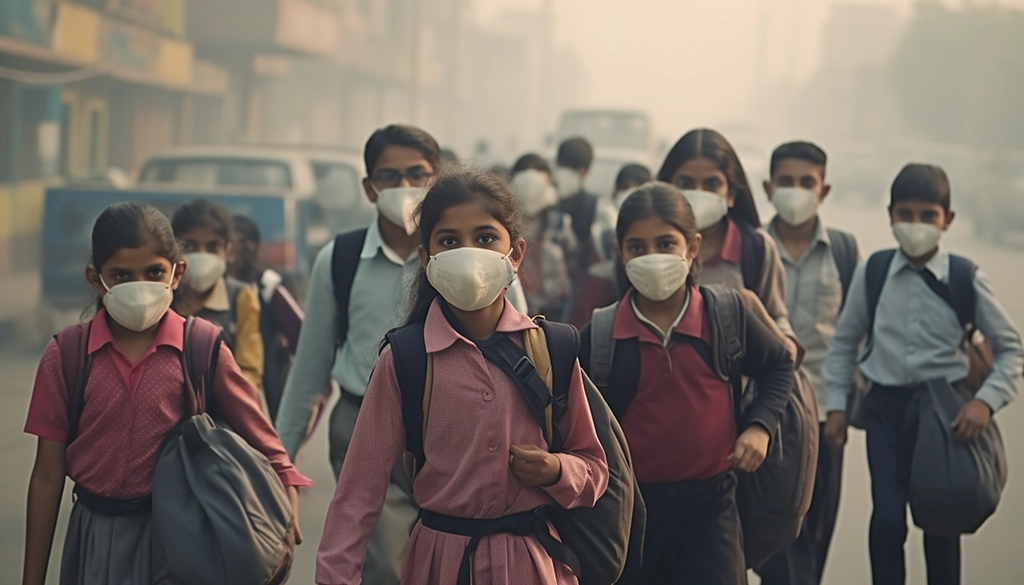Introduction
Air pollution in Delhi has reached a critical juncture, where every breath taken in the city raises concerns about health and well-being. Recent developments have spotlighted this issue with unprecedented urgency. The Supreme Court of India has stepped in, issuing directives to address the problem head-on. However, the discourse on air pollution in Delhi requires a unique perspective, one that unveils the hidden facets of this crisis. In this article, we delve into the often-ignored aspects and provide a comprehensive view of the issue, presenting facts that may surprise you.
Table of Contents
Fact 1: Delhi’s Alarming Air Quality Index (AQI)
Defining the Air Quality Index (AQI)
First, it’s crucial to understand the Air Quality Index (AQI) and its implications. The AQI is a measure of air quality that encompasses various pollutants, including PM2.5, PM10, carbon monoxide, sulfur dioxide, and nitrogen dioxide. The higher the AQI value, the worse the air quality, posing more significant health risks.
Delhi’s Consistent Ranking
Delhi consistently finds itself at the lower end of the global AQI rankings. It’s a city where residents experience the harsh reality of ‘severe’ to ‘hazardous’ air quality for a significant part of the year. This disturbing consistency challenges the perception that air quality may improve over time and highlights the persistent nature of the issue.

Unconventional Insight
An unconventional perspective is necessary to recognize that air pollution in Delhi has been a long-standing problem. It’s not just a recent issue; it’s a chronic condition. This viewpoint prompts us to address the issue with more determination, acknowledging that solutions need to be as enduring as the problem itself.
Fact 2: The Role of Vehicular Emissions
The Impact of Vehicular Emissions
Vehicles play a major role in air pollution in Delhi crisis. The large number of vehicles on the city’s roads significantly contributes to emissions of particulate matter and harmful gases. This impact is well documented, and measures have been taken to mitigate it.

An Overlooked Aspect
While the role of vehicular emissions is well-known, a less-discussed facet is the prevalence of diesel vehicles in Delhi. Diesel vehicles, which emit more particulate matter and harmful compounds, are still widely used in the city. Recognizing this lesser-discussed aspect emphasizes the need for stricter regulations and incentives to transition to cleaner alternatives.
Fact 3: Industrial and Construction Emissions
The Industrial Connection
The industries in Noida and Ghaziabad are substantial contributors to Delhi’s air pollution. These areas house numerous factories and manufacturing units, releasing a significant amount of pollutants into the atmosphere. Their contribution, approximately 15% of the city’s pollution, cannot be understated.

Construction Pollution
Construction sites have become hotspots for pollution. The dust and pollutants generated from these sites are adding complexity to Delhi’s air pollution problem. While construction-related pollution may not always make the headlines, it plays a pivotal role and must be addressed.

Data from the National Green Tribunal
Data from the National Green Tribunal highlights the extensive presence of industries in the Noida and Ghaziabad regions. This data substantiates the significant role played by these industries in contributing to Delhi’s air pollution.
Fact 4: Stubble Burning and Its Real Share in Air Pollution in Delhi
Challenging the Misconception
Stubble burning, a seasonal concern primarily linked to Punjab and Haryana, has long been considered the primary culprit behind Delhi’s poor air quality. However, this widely held belief is misconstrued.

Numerical Perspective
The misconception is debunked when we examine the numbers. Stubble burning, while impactful, contributes only about 10% to the air pollution crisis in Delhi-NCR. This numerical perspective highlights the need to focus on the remaining 90% and acknowledge the many other significant contributors to air pollution that require attention.
Fact 5: Demographic Connection with Pakistan During Smog Season
Shared Concerns
As winter descends upon Delhi, it brings not only colder temperatures but also a phenomenon that transcends borders. Smog affects not just Delhi but also its neighbor, Pakistan. This shared concern emphasizes that air pollution knows no boundaries and affects neighboring regions as well.

Cross-Border Collaboration
The demographic connection during the smog season underscores the importance of cross-border collaboration. It challenges the perception that air pollution is a local problem and highlights the need for regional cooperation. Air pollution respects no borders, and effective solutions may necessitate coordinated efforts.
Fact 6: Government Initiatives and Challenges
Government Efforts
The Delhi government has been proactive in addressing air pollution. Initiatives like the Odd-Even scheme, the promotion of CNG-powered public transportation, and stricter emission norms for vehicles have been implemented.
Ongoing Challenges
Despite these commendable initiatives, challenges persist. Implementing such measures on a large scale requires overcoming resistance, ensuring compliance, and managing the logistics of these programs. These challenges underscore the complexity of the issue and the need for innovative, multi-pronged solutions.

Fact 7: Public Awareness and Advocacy
Public Participation
Air pollution awareness isn’t limited to government action. NGOs, citizen-led initiatives, and concerned individuals play a crucial role in raising awareness and advocating for cleaner air. Public participation is integral to tackling the problem effectively.

Community Efforts
Grassroots movements, involving local communities and individuals, have shown that change is possible. These efforts bring to light the power of collective action, emphasizing the importance of individuals and communities in the fight against air pollution.
Fact 8: Steps Towards a Cleaner Delhi
Solutions and mitigation
The road to a cleaner Delhi involves several practical steps. Individuals can contribute by choosing cleaner transportation options, such as carpooling, public transportation, or electric vehicles. Governments must continue to promote these options and enforce stricter emission norms for vehicles.
Hope for Improvement
While the air pollution crisis in Delhi may seem daunting, there is hope. By working together, taking individual and collective actions, and promoting innovative solutions, Delhi can look forward to cleaner air and a healthier future.
Fact 9: The Overlooked Role of Indoor Air Pollution
While discussions about air pollution in Delhi often focus on the outdoors, it’s essential to shine a light on the often-overlooked concern of indoor air quality. Indoor air pollution can be as detrimental to health as outdoor pollution. Factors such as inadequate ventilation, the use of fossil fuels for cooking or heating, and the presence of allergens can significantly impact the air quality inside homes. Residents of Delhi must not only consider the air they breathe on the streets but also within the confines of their homes.
This underlines the need for greater awareness about indoor air quality and the adoption of cleaner and safer practices within households. It’s a facet of air pollution that complements the broader picture of Delhi’s air quality, and addressing it is crucial for comprehensive solutions.
Fact 10: Collaborative Efforts for Regional Change
Air pollution respects no geopolitical boundaries. The smog that engulfs Delhi during the winter season extends its reach across neighboring regions, including parts of Pakistan. This shared concern highlights the need for collaborative efforts that transcend borders. Solutions to the air pollution crisis must involve coordinated actions between regions, acknowledging the demographic and environmental connections that affect both areas.
Cross-border collaboration could involve sharing air quality data, mutual agreements on reducing smog-related activities, and collaborative research to identify the shared contributors to air pollution. By working together, regions can better address the challenges posed by air pollution, recognizing that effective solutions require collective action.
Conclusion
In conclusion, the issue of air pollution in Delhi is complex and multifaceted, demanding comprehensive solutions. This article has presented ten eye-opening facts, challenging conventional wisdom and offering a fresh perspective on the problem.
As we navigate Delhi’s challenging air quality, it’s essential to:
Acknowledge the significance of the Air Quality Index (AQI) in understanding the problem.
Recognize the pervasive issue of vehicular emissions and the overlooked aspects of this contributor.
Address the role of industrial and construction emissions in deteriorating air quality.
Challenge misconceptions about the extent of stubble burning’s contribution to pollution.
Understand the demographic connection with Pakistan during the smog season and the importance of cross-border cooperation.
Appreciate government initiatives and the challenges they face in execution.
Recognize the pivotal role of public awareness and grassroots advocacy.
Explore practical steps toward a cleaner Delhi and maintain hope for improvement.
Consider indoor air pollution and its impact on health.
Embrace collaborative efforts for regional change.
In this journey towards cleaner air, each individual and stakeholder must play their part. Addressing air pollution is a collective responsibility, requiring innovation, awareness, and determination.
FAQs
1. Is stubble burning the main cause of air pollution in Delhi?
No, stubble burning is a significant contributor to air pollution in Delhi, but it is not the primary cause. Recent data indicates that stubble burning contributes only about 10% to the air pollution crisis in Delhi-NCR. There are several other factors, such as industrial and construction emissions, vehicular pollution, and cross-border influences, that play substantial roles in deteriorating air quality.
2. What can the government do to combat air pollution in Delhi?
The government can take several steps to combat air pollution, including promoting cleaner transportation options, implementing stricter emission norms for vehicles, regulating industrial and construction emissions, and encouraging cross-border collaboration during the smog season. Government initiatives are critical, but they also face challenges in execution, requiring public support and accountability.
3. How can individuals contribute to improving air quality in Delhi?
Individuals can contribute by reducing their carbon footprint through actions like carpooling, using public transportation, and transitioning to electric vehicles. They can also support local and national policies aimed at reducing pollution, raising awareness about the health hazards of air pollution, and engaging in grassroots advocacy for cleaner air.
4. What role does construction pollution play in air quality in Delhi?
Construction pollution is a growing concern in Delhi, particularly in the National Capital Region (NCR). The dust and pollutants released from construction sites contribute significantly to air pollution. Addressing this issue involves enforcing stricter regulations and promoting cleaner construction practices to mitigate its impact.
5. How can Delhi and neighboring regions collaborate to combat smog during the winter season?
Collaboration between Delhi and neighboring regions, including Pakistan, is essential during the smog season. The shared concern over smog highlights the need for cross-border cooperation. Effective solutions may require coordinated efforts, such as sharing air quality data and implementing measures to reduce smog across regions.









1 thought on “10 Eye-Opening Facts About Air Pollution in Delhi: Unraveling the Crisis”